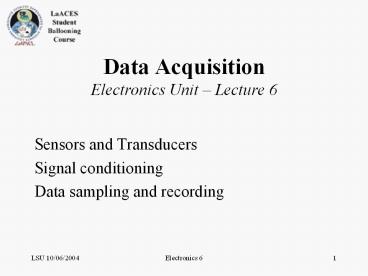Data Acquisition Electronics Unit – Lecture 6 - PowerPoint PPT Presentation
1 / 17
Title:
Data Acquisition Electronics Unit – Lecture 6
Description:
Data Acquisition Electronics Unit Lecture 6 Sensors and Transducers Signal conditioning Data sampling and recording Data Acquisition Sensors and Transducers ... – PowerPoint PPT presentation
Number of Views:150
Avg rating:3.0/5.0
Title: Data Acquisition Electronics Unit – Lecture 6
1
Data Acquisition Electronics Unit Lecture 6
- Sensors and Transducers
- Signal conditioning
- Data sampling and recording
2
Data Acquisition
SENSOR
TRANSDUCER
SIGNAL CONDITIONING
ANALOG-TO-DIGITAL CONVERSION
DATA COLLECTION AND STORAGE
READOUT AND/OR DISPLAY
3
Sensors and Transducers
- Sensor responds to a physical variable
- Transducer converts a sensor response to an
electrical signal - Often the sensor and transducer are integrated
into a single unit example, the thermistor
converts temperature into resistance.
4
Some Physical Variables(possible sensor inputs)
- Temperature Pressure Force
- Humidity Light Intensity Position
- Radioactivity Acceleration Attitude
- Magnetic field strength
- Electric field strength
- Chemical composition
5
Some Electrical Signals(possible transducer
outputs)
- Resistance
- Voltage
- Current
- Pulse frequency
- Pulse width
6
Temperature Measurement
- Convert temperature to resistance? Use
- Thermistor, RTD (resistance temperature device)
- Thermistor has negative TC, RTD has positive TC
- Convert temperature to voltage? Use
- Thermocouple (Seebeck effect)
- Convert temperature to current? Use
- Semiconductor junction devices
7
Magnetic Field Measurement
- Hall Effect devices for higher field strengths
- from a few tens to a few hundreds of gauss
- Magnetoresistive devices for lower field
strengths - can sense small fractions of a gauss
- (used in electronic compasses)
8
Light MeasurementsIncludes Visible, Infrared,
and Ultraviolet
- Photoresistor resistance decreases with light
intensity - Photodiode reverse current increases with
intensity - Phototransistor an amplified photodiode
- Photomultiplier tube most sensitive of all
- Requires high voltage supply
9
Pressure Measurements
- Solid state pressure transducers
- Can sense gauge or absolute pressure
- Output is usually a voltage signal
- Usually a hybrid electromechanical device
- Temperature compensation is essential
10
Signal Conditioning
- Filtering to reduce noise or interference
- Amplification or Attenuation
- Level shifting
- Span and Base adjustment
- Impedance transformation
11
Span and BaseApplies to both the physical
variable and the electrical signal
- Example
- Temperature sensor -20 to 150 degrees Celsius
- BASE -20 degrees, SPAN 170 degrees
- Transducer output 4 mA to 20 mA of electric
current - BASE 4 mA, SPAN 16 mA
- So 11.6 mA corresponds to 60.8 degrees (work it
out!)
12
Analog to Digital Conversion
- Changes a continuous electrical signal into a
discrete numerical value, represented by a binary
number. - Will be the topic of a separate presentation
later on the course.
13
Data Collection Sampling Rate
- The Nyquist Rate
- A signal must be sampled at a rate at least twice
that of the highest frequency component that must
be reproduced. - Example Hi-Fi sound (20-20,000 Hz) is generally
sampled at about 44 kHz.
14
BalloonSat as a Data Acquisition System
- BASIC Stamp BS2P24
- 24LCxx EEPROM
- Real Time Clock
- 4 channel A/D converter
- Voltage reference for ADC
- Temperature sensor
- 4 LED indicators
15
HOBO Data Logger
- Combines sensors, transducers, signal
conditioning, A/D conversion, storage, and
readout into a compact, battery powered unit.
16
Further Reference
- See Input/Data Acquisition System Design for
Human Computer Interfacing - By William Putnam and R. Benjamin Knapp
- Included as an HTML document in the References
folder of the Electronics Unit
17
Activity E6
- Use the HOBO data Logger and BoxCar support
software to collect temperature data.































